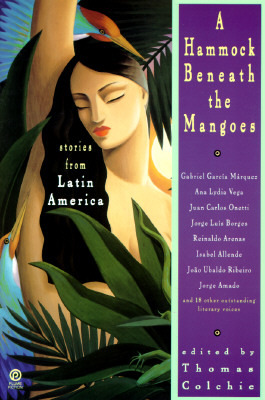Lyrical Prose Amid the Mangoes and Hammocks
Latin American literature is so old that the rocks were still warm from Creation when it began. It is as mercurial as the first fish you ever caught & then tried to land with only your human hands. Remember that?
It is a style of writing that is as indefinable as that very word itself. And that is a part of what makes Latin American Literature fun, unique, a self-defined art form.
As a North American, most of the literature I have read by Latin American authors has been novels, although I have read some Latin poetry, too. Let me also state that I am a big fan of the short story as an art form, in any language. I like the brevity, the maintenance of structure, the importance & impact of every word.
So I was happy to discover A Hammock Beneath the Mangroves, a compilation of short stories by modern Latin American authors, simply because I haven’t read many short stories by Latin American authors.
Published by Plume Books with adroit editing by Thomas Colehie, this book has been a pleasant education for me. It offers writings by twenty-six Latin American authors, some translated into English for the first time in this publication.
Each story is preceded by a short bio about the author. These little life histories offer their own chalice of information, their smudge of humanity about the writer.
Then the tales unfold. Some are scrumptious. The Isabel Allende erotica offering, “Toad’s Mouth” laced with comedy, for example. “Relative Humidity” by Argentinian Manuel Puig was a revelation for me, a glimpse into early Magical Realism. And “Journey Back to the Source” by the noted Cuban author Alejo Carpentier could be the subtle “sleeper” of the collection.
The book is partitioned into geographical sections starting with The River Plate (suggesting northern South America on the east side) & then Chile with sadly just one entry, my friend Isabela Allende.
The compilation then dives deeply into Brazil to include no less than eleven short stories, beginning with “The Miracle of the Birds” by Jorge Amado, a story beautiful enough to allow their overt favoritism.
The collection finally moves drastically north in the Latin American world to include two stories from Mexican writers including “The Doll Queen” by Carlos Fuentes, a modern writer I truly admire, before swinging East, finally, to the Caribbean to include Gabriel Garcia Marquez with “The Last Voyage of the Ghost Ship”.
I have to say that I am a bit surprised that the Peruvian writer Mario Vargas Llosa has not been included. In my opinion, he represents a rebelliousness that I thought most Latino editors and publishers would want to frame with neon lights.
I found this book on a shelf in my store: Jaime Peligro in Tamarindo. It practically jumped into my hands.
Come in some time. You might have a similar Latin American experience in literature waiting for you!


